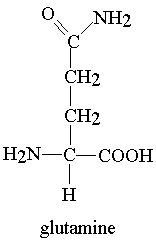MTX與Glutamine共同使用的危險

Methotrexate is a weak acid that is excreted primarily through the kidneys. Salicylates, nonsteroidal antiinflammatory drugs, probenecid, penicillins, cephalosporins and other drugs that lower urinary pH may decrease methotrexate elimination and cause precipitation of methotrexate in the renal tubules with a resultant acute nephrotoxicity.1 Glutamine is a dietary supplement used to prevent chemotherapy-related gastrointestinal toxicity, especially that associated with methotrexate-linked mucositis. Glutamine (30 g/day) is administered to adult patients beginning one week before the initiation of chemotherapy, and treatment concludes two weeks after completion of chemotherapy.2 A pediatric dosage has not yet been established.
The elimination half-life of glutamine following i.v. administration is one hour. It is excreted by the kidneys after glomerular filtration, although it is almost completely reabsorbed through the renal tubules. Glutamine metabolism in the kidney occurs via an initial deamination process that generates ammonium and a carbon skeleton that can then be converted into glucose and ultimately bicarbonate, which subsequently returns to the plasma. A portion of the ammonium is excreted in the urine, and nonexcreted ammonium is metabolized in the liver to produce urea in a process that consumes bicarbonate. The ammonium excreted in urine increases urinary acid excretion.3
We saw a 14-year-old boy with lymphoblastic T-cell lymphoma who was taking glutamine 20 g/day and had nephrotoxicity associated with the administration of high-dose methotrexate. Twenty-four hours after the start of the methotrexate infusion, the plasma methotrexate concentration was 245 µmol/L, which exceeded the value associated with toxicity (150 µmol/L).4 The serum creatinine concentration was 2.7 mg/dL, and the estimated creatinine clearance was 32 mL/min. The patient was not taking any other drugs known to interfere with methotrexate elimination.
Glutamine had been administered at the same dosage for two previous courses of chemotherapy; it was necessary to adjust the urinary pH throughout those courses with an i.v. sodium bicarbonate bolus of 20 mEq in addition to the standard hydration protocol. Nephrotoxicity did not occur until the third course of methotrexate, during which adjustment of urinary pH did not occur, probably because urine was not collected during the long methotrexate infusion period. As a result, the decrease in pH to <7 was not detected until after the infusion was complete, when nephrotoxicity became evident. The patient did not have evident malignant effusions that might have prolonged methotrexate elimination. The plasma methotrexate concentrations remained above 0.2 µmol/L until the 10th day after infusion, and the serum creatinine concentration did not stabilize (at 1.1 mg/dL) until the 14th day after infusion.
The effect of glutamine on circulating plasma bicarbonate concentration and urinary acid excretion has been demonstrated by Welbourne et al.5, who measured the concentration of plasma bicarbonate and the urinary pH before and after oral administration of glutamine 2 g in healthy volunteers. In addition, a significant pharmacokinetic interaction between methotrexate and glutamine has been reported in animal models, in which glutamine reduced total methotrexate plasma clearance by 25% and renal methotrexate elimination by 65%.
The urinary pH of patients receiving glutamine and high-dose methotrexate should be continually checked and adjusted, because a glutamine-associated reduction in urinary pH can result in high plasma levels of methotrexate and nephrotoxicity due to methotrexate precipitation in the renal tubules. In addition, the potential benefits of glutamine administration in such cases should be carefully evaluated against the potential risks to the patient.
References
- Methotrexate. In: E Chu and VT De VitaJr. Physicians’ cancer chemotherapy drug manual, 2004. Sudbury, MA: Jones and Bartlett; 2003.
- Glutamine. In: Drugdex system [Internet database]. Greenwood Village, CO: Thomson Reuters. Updated periodically.
- Hamm LL and Nakhoul NL. Renal acidification. In: BM Brenner, ed. Brenner and Rector’s the Kidney edition, 8th ed. Philadelphia: Saunders; 2008.
- Fernández Megía MJ, Alós Alminana M and Terol Castera MJ. [Managing methotrexate toxicity: a case report]. Farm Hosp. 2004; 28:371–4. In Spanish.
- Welbourne T, Claville W and Langford M. An oral glutamine load enhances renal acid secretion and function. Am J Clin Nutr. 1998; 67:660–3.
- Charland SL, Bartlett DL and Torosian MH. A significant methotrexate-glutamine pharmacokinetic interaction. Nutrition. 1995; 11:154–8.





 留言列表
留言列表
 線上藥物查詢
線上藥物查詢 